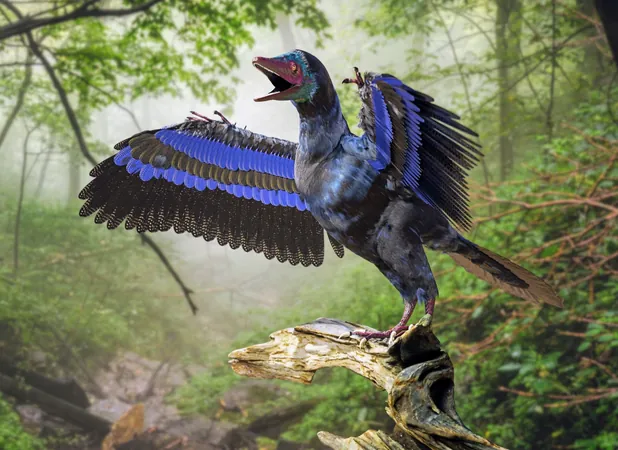
The Evolutionary Secret: How 'Wiggly' Skulls Transformed Dinosaurs into Modern Birds!
2025-03-21
Author: Nur
Modern birds share an intriguing relationship with their prehistoric ancestors, the dinosaurs. Striking similarities can be observed when we look at flightless species such as chickens and ostriches, which walk upright on two legs, in contrast to the predatory hawks and eagles that utilize sharp talons and acute senses. However, birds have branched off significantly from their reptilian predecessors, most notably through their evolution of larger brains, which directly influenced changes in skull size and shape.
Recent research conducted by experts at the University of Chicago and the University of Missouri has revealed how these crucial physical transformations have impacted bird movement and the way they use their beaks for feeding and interacting with their environment. This research aids in understanding how birds became one of the most diverse lineages on our planet.
The Fascinating 'Wiggly' Skull
A standout feature of modern birds, along with certain snake and fish species, is the flexibility of their skulls—unlike many other animals, their jaws and palates are not rigidly attached. This unique design, referred to as a "wiggly" skull by Alec Wilken, a graduate student and lead researcher in the study, presents a challenge in comprehending its functionality. He notes, “Just because you have a joint there doesn’t mean you fully understand how it moves. It’s essential to consider the muscles acting on the joint and how they interact with the rest of the skull.”
Tracing the Evolutionary Journey of Bird Skulls
Wilken's involvement in the project dates back to 2015 during his studies at the University of Missouri, where he collaborated with Casey Holliday, an associate professor, to investigate the evolutionary trajectory of bird skulls and their jaw muscles from dinosaurs. Utilizing advanced computer tomography (CT) scans of both fossil and modern bird skulls, alongside other reptiles like alligators, the team developed sophisticated 3D models. These models helped to illustrate muscle positions and movements, providing insight into their functional dynamics.
Advantages of the Modern Bird Skull
A distinctive characteristic of today’s birds is cranial kinesis—the capability to operate different skull sections independently. This adaptability grants birds an evolutionary advantage, allowing them to open their beaks in unique ways and expand their palates during feeding, significantly increasing their survival capability. As Wilken notes, “A wiggly head provides immense evolutionary benefits.” For instance, parrots utilize their beaks not only for feeding but also for climbing, while others break tough seeds—demonstrating the beak's versatility akin to a tool.
From Dinosaurs to Birds: A Remarkable Transition
The investigation of 3D models revealed a fascinating evolutionary cascade: as non-avian theropod dinosaurs evolved, their brains and skulls enlarged, leading to restructured muscle arrangements that fostered greater palatal and jaw mobility. This transition marked an increase in muscle force and cranial kinesis prevalent in most modern birds.
Holliday remarked, “We observe a sequence of transformative changes during the transition from dinosaurs to birds. The evolution of a relatively large brain was pivotal, similar to trends seen in humans where larger brains propel alterations in skull morphology.”
Paleontological evidence illustrates that the distinction between dinosaurs and birds is often blurred, especially considering that many feathered dinosaurs exhibited flight capabilities. Researchers speculate that the advent of truly flexible skulls and palates manifested well after the emergence of species like Archaeopteryx, indicating that cranial kinesis might play a pivotal role in differentiating modern birds from their more primitive counterparts.
Shaping Future Insights
Although it is widely accepted that modern birds descended from ancient reptiles, the intricate genetic and mechanical pathways of that transition remain an area of deep exploration. The latest findings underscore how the synergy between increased brain size and adaptive skull modifications liberated bird jaws and palates, resulting in remarkable ecological diversity.
This ongoing research illuminates the complex interplay of evolutionary forces at work since the era of dinosaurs. As scientists continue to decipher the abilities of bird beaks, we edge closer to understanding the foundational role early dinosaur species played in shaping today’s rich avian biodiversity.
This groundbreaking study is documented in the *Proceedings of the National Academy of Sciences*.
Stay tuned for more captivating insights into the evolutionary narratives that continue to shape our natural world!


 Brasil (PT)
Brasil (PT)
 Canada (EN)
Canada (EN)
 Chile (ES)
Chile (ES)
 Česko (CS)
Česko (CS)
 대한민국 (KO)
대한민국 (KO)
 España (ES)
España (ES)
 France (FR)
France (FR)
 Hong Kong (EN)
Hong Kong (EN)
 Italia (IT)
Italia (IT)
 日本 (JA)
日本 (JA)
 Magyarország (HU)
Magyarország (HU)
 Norge (NO)
Norge (NO)
 Polska (PL)
Polska (PL)
 Schweiz (DE)
Schweiz (DE)
 Singapore (EN)
Singapore (EN)
 Sverige (SV)
Sverige (SV)
 Suomi (FI)
Suomi (FI)
 Türkiye (TR)
Türkiye (TR)
 الإمارات العربية المتحدة (AR)
الإمارات العربية المتحدة (AR)